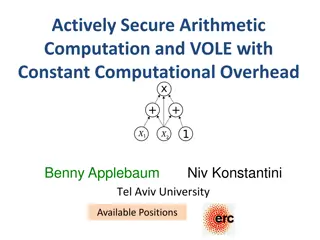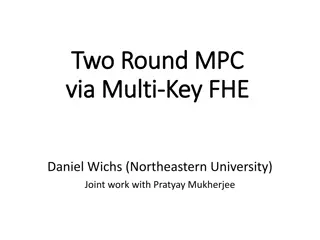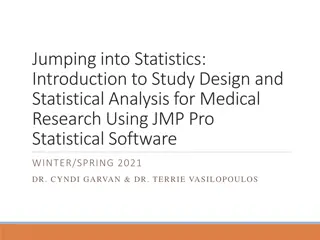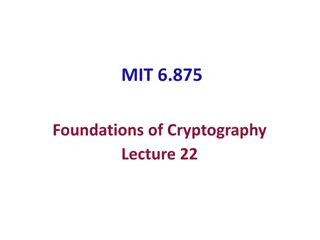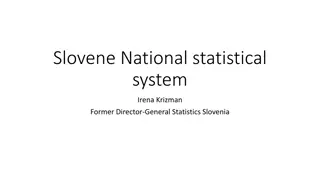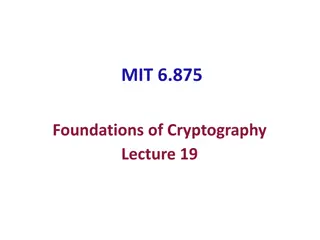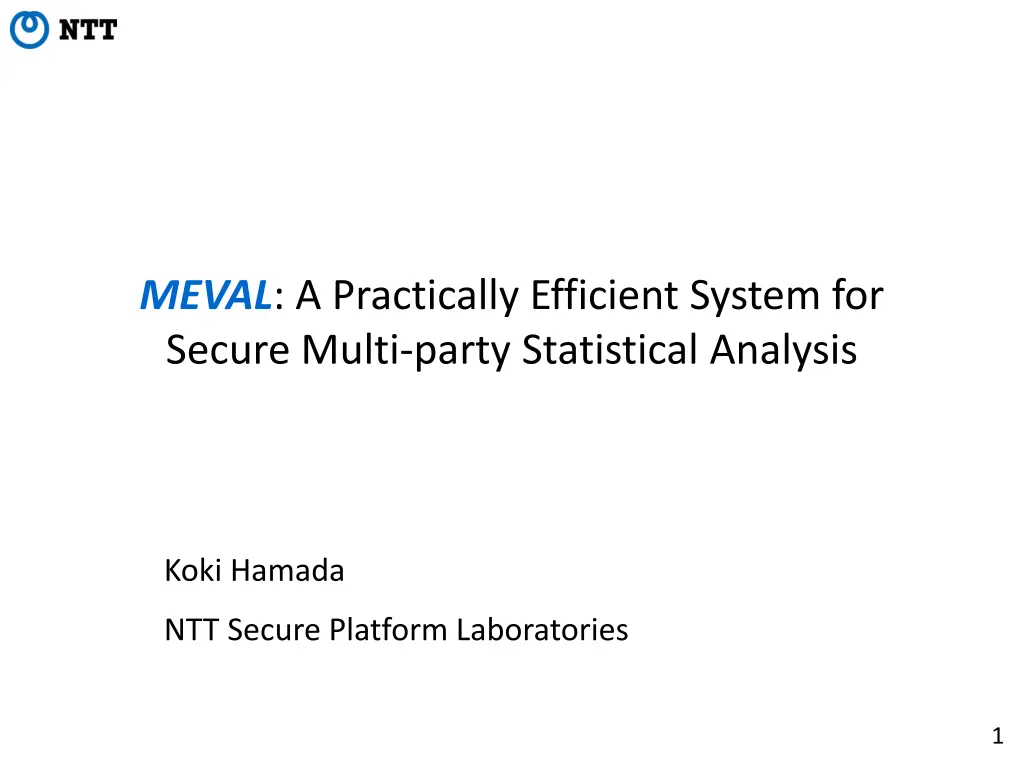
Secure Multi-party Statistical Analysis System - MEVAL Overview
Explore MEVAL, a practical system for secure multi-party statistical analysis designed for efficient and secure computation with features like 8.7 MIPS and 61-bit multiplication. MEVAL allows for secure outsourcing of data storage and analysis, enabling data holders to maintain privacy while benefiting from advanced statistical functions.
Download Presentation

Please find below an Image/Link to download the presentation.
The content on the website is provided AS IS for your information and personal use only. It may not be sold, licensed, or shared on other websites without obtaining consent from the author. If you encounter any issues during the download, it is possible that the publisher has removed the file from their server.
You are allowed to download the files provided on this website for personal or commercial use, subject to the condition that they are used lawfully. All files are the property of their respective owners.
The content on the website is provided AS IS for your information and personal use only. It may not be sold, licensed, or shared on other websites without obtaining consent from the author.
E N D
Presentation Transcript
MEVAL: A Practically Efficient System for Secure Multi-party Statistical Analysis Koki Hamada NTT Secure Platform Laboratories 1
Overview Introduction of our MPC system MEVAL (Multi-party EVALuator) Main features of MEVAL: 8.7 MIPS (million instructions per second) 61-bit multiplication 6.9 seconds for Sorting1 million 20-bit items 2
Outline Overview of MEVAL Performance Techniques Demonstration 3
MEVAL (Multi-party EVALuator) Design concept of MEVAL: general purpose high-performance secure computation system MPC system based on secret sharing Built on Shamir s secret sharing scheme The number of parties is 3 Corruption tolerance is 1 Secure against passive adversaries Values are 61-bit word Mersenne prime field ?with ? = 261 1 is used for efficiency (mechanism is discussed later) 5
Intended application Secure outsourcing of data storage and analysis 1. Data holders outsource data storage to MEVAL servers 2. Servers conduct analysis on request and return the result Requirement: MEVAL servers never see the stored data 1. MEVAL servers 2. 6
Implemented operations Basic MPC protocols Dealing, revealing Addition, multiplication Bet-decomposition, comparison, equality test Fully realized as MPC protocols Shuffling Sorting Statistical functions Count, sum, min, max, median, sum of squares Computed from revealed count, sum, and sum of squares Mean, variance, Student s t-test 7
Practical accomplishments of MEVAL Joint experiment with a medical study group, 2011 2013 Analyses conducted in clinical research were replicated on MEVAL Mean, variance, min, max, median, survival analysis, tests, etc. 1,057 808 real clinical data of adult leukemia patients were used Joint research with a university hospital, 2012 Performance evaluation of MEVAL Intended application: analysis on real medical receipt 50,001 38 dummy insurance claim data were used Joint research with Japanese statistics bureau, 2012 Performance evaluation of MEVAL Intended application: advanced use of official statistics 10,128 176 official statistic data were used Data holders requirements: better security without performance loss 8
Experimental outline Run on 3 desktop machines CPU: Intel Core i7 3930K 3.2 GHz RAM: 20 GB SSD: 128 GB OS: Linux (Ubuntu 12.04) Networks: 1-Gbps LAN, 10-Gbps LAN, 200-Mbps WAN Performance of basic MPC protocols were measured Addition, multiplication, shuffling (with 61-bit input values) Equality test, comparison, sorting (with 20-bit input values) Size of field is ? = 261 1, but secret values are known to be less than 220 10
Performance on 1-Gbps LAN Running-time on 1-Gbps LAN in seconds Input values were randomly chosen ??? ??? ??? ??? # items Addition 0.001 0.001 0.012 0.138 = 724.63 MIPS Multiplication 0.017 0.135 1.191 11.449 = 8.73 MIPS Shuffling 0.031 0.234 2.603 29.073 = 3,439,617 items/s Equality test (20-bit) 0.839 0.668 0.880 9.024 = 11.08 MIPS Comparison (20-bit) 0.413 0.287 0.592 13.680 = 7.30 MIPS Sorting (20-bit) 0.738 6.875 73.382 - = 136,273 items/s 11
Performance on 10-Gbps LAN Running-time on 10-Gbps LAN in seconds Input values were randomly chosen ??? ??? ??? ??? # items Addition 0.001 0.001 0.012 0.139 = 719.42 MIPS Multiplication 0.017 0.050 0.469 4.752 = 21.04 MIPS Shuffling 0.020 0.118 1.315 15.073 = 6,634,379 items/s Equality test (20-bit) 0.710 0.664 0.674 2.689 = 37.18 MIPS Comparison (20-bit) 0.322 0.263 0.287 1.699 = 58.85 MIPS Sorting (20-bit) 0.253 2.211 30.207 - = 331,049 items/s 12
Performance on WAN Running-time on WAN in seconds 200-Mbps best-effort delivery network was used Network delay between machines were 24.6 , 36.1 and, 46.7 ms Input values were real medical data # items 1 100 1,547 10,829 108,290 Addition - 0.001 0.001 0.001 0.002 = 54.009 MIPS Multiplication - 0.091 0.063 0.074 0.233 = 0.464 MIPS Shuffling - 0.059 0.062 0.125 0.671 = 161,385 items/s Equality test (20-bit) 0.970 0.930 1.030 1.591 5.468 = 0.019 MIPS Comparison (20-bit) 0.634 0.771 0.961 1.647 6.174 = 0.017 MIPS Sorting (20-bit) 1.075 1.032 0.772 1.595 12.723 = 8,511 items/s 13
Techniques used in MEVAL Implementation techniques Efficient high-level protocols 15
Implementation techniques Careful implementation was done for real-world performance Main points of our efficient implementation are: 1. Asynchronous processing 2. Pseudorandom secret sharing technique implemented with AES-NI 3. Optimized field operations on Mersenne prime field 16
Without asynchronous processing In our settings, times consumed by data transfer and local computation are comparable So, na ve implementation leaves many resources unused Example: cascade conductions of MPC protocols 1stconduction 2ndconduction Receive Compute Send Receive Compute Send Receive Network usage CPU usage 17
Implementation techniques Careful implementation was done for real-world performance Main points of our efficient implementation are: 1. Asynchronous processing 2. Pseudorandom secret sharing technique implemented with AES-NI 3. Optimized field operations on Mersenne prime field Running time details (before applying our ideas): Time consumed by sending/receiving Time consumed by local computation Running time 18
Asynchronous processing Asynchronous implementation enables better resource usage Send Thread 1 Receive Compute Send Receive Compute Thread 2 Receive Compute Send Receive Compute Thread 3 Receive Send Compute Network usage CPU usage 19
Implementation techniques Careful implementation was done for real-world performance Main points of our efficient implementation are: 1. Asynchronous processing 2. Pseudorandom secret sharing technique implemented with AES-NI 3. Optimized field operations on Mersenne prime field Running time details: Time consumed by sending/receiving Time consumed by local computation Running time 20
Balancing resource usage If implementation is asynchronous, maximum of resource usages determines total running time Case #1 Case #2 Case #3 Sending/receiving 30 s 8 s 18 s 8 s 30 s 20 s Computation 30 s 30 s 20 s Running time Balancing resource usage is important for reducing running time on asynchronous implementation 21
Pseudorandom secret sharing Pseudorandom secret sharing technique [CDI05] is used to convert network communication to local computation Almost half of communications can be converted to local computation AES-NI is used to obtain 30-Gbps pseudorandom generation Typical communication on 3-party MPC: mask and send (0) ?1and ?3share a seed for pseudorandom (1) Generate random ? (1) Generate pseudorandom ? ?1 ?1 (1) Generate pseudorandom ? (2) Send ? + ? (2) Send ? (2) Send ? + ? ?2 ?3 ?2 ?3 22
Implementation techniques Careful implementation was done for real-world performance Main points of our efficient implementation are: 1. Asynchronous processing 2. Pseudorandom secret sharing technique implemented with AES-NI 3. Optimized field operations on Mersenne prime field Running time details: Time consumed by sending/receiving Time consumed by local computation Running time 23
Mersenne prime field operation Local computations mainly consist of the following operations: Throughputs over prime field ? (? ???) ? (? ???) Throughputs over prime field Throughputs over Mersenne prime field ?(? = ??? ?) - Pseudorandom number generation - Pseudorandom number generation 30-Gbps 30-Gbps 30-Gbps - Field addition - Field addition 12-Gbps 12-Gbps 70-Gbps - Field multiplication - Field multiplication 0.5-Gbps 0.5-Gbps 30-Gbps Example: Multiplication (computing ?? mod ?) on Mersenne prime field ?: 1. ? ?? 2. ?? (higher |?| bits of ?) ?? (lower |?| bits of ?) 3. ? ??+ ?? 4. if ? > ? then ? ? ? 5. Return ? 24
Implementation techniques Careful implementation was done for real-world performance Main points of our efficient implementation are: 1. Asynchronous processing 2. Pseudorandom secret sharing technique implemented with AES-NI 3. Optimized field operations on Mersenne prime field Running time details: Time consumed by sending/receiving Time consumed by local computation Running time 25
Our efficient protocols Efficient high-level protocols were also investigated: Bit-decomposition for small number of parties Radix sort protocol 26
Our bit-decomposition protocol Bit-decomposition protocol for when bit-length of secret is known to be small was developed Communication complexity: 10 + 4 bits Better than that of multiplication (6log?) when is small Round complexity: + 1 Example: = ?? and ? = ??? ? Communication complexity Round complexity 366 (= 61 6) bits Multiplication 1 Our bit-decomposition 204 bits 21 Running time on 10-Gbps LAN ??? ??? ??? ??? # items Multiplication 0.017 0.050 0.469 4.752 = 21.04 MIPS Comparison (20-bit) 0.322 0.263 0.287 1.699 = 58.85 MIPS 27
Our bit-decomposition protocol (contd.) Our bit-decomposition protocol is based on two ideas: 1. Replicated secret sharing over 2is used for shared bits Using smaller field saves communication complexity of protocols on bits We can compute XOR on shared bits for free 2. Efficient over flow detection when we know + 1 < log? When 0 2?,?,? < ? and 2? = ? + ? mod ?, ? + ? ? iff ?0 ?0= 1 We can remove full-bit addition circuit computation with this technique 28
Our sorting protocol Sorting protocol with ? ?log? communication in ? 1 rounds was developed ? is # input items # parties and field size ? are assumed to be constant Our sorting protocol is based on radix sort algorithm Radix sort algorithm: 1 1 1 0 1 1 0 0 1 0 0 1 1 1 0 1 1 1 1 0 1 0 0 0 1 0 0 1 1 1 1 1 1 1 0 0 0 0 1 1 0 1 1 0 1 0 1 1 1 1 1 0 0 0 1 1 0 1 1 0 Bit-decomposition and bitwise stable sort protocols are sufficient to construct MPC radix sort protocol 29
Our sorting protocol (contd.) Our technique: Shuffle and reveal MPC bitwise stable sort: Computing destinations Shuffling Revealing 1 0 0 1 0 4 1 2 5 3 4 3 2 1 5 0 0 1 1 0 0 0 0 1 1 1 2 3 4 5 In addition, Shuffle and reveal technique is again used to improve efficiency of resultant MPC radix sort protocol 30
Outline of demonstration MEVAL is demonstrated on this laptop PC Client program (R with add-on) runs on host OS (Windows 7) Three server programs runs on a single virtual machine (Ubuntu 12.04) This laptop PC (Thinkpad) Virtual machine (Ubuntu 12.04) Process #1 (MPC server #1) Process #2 (MPC server #2) R with add-on (Client program) Process #3 (MPC server #3) 32









